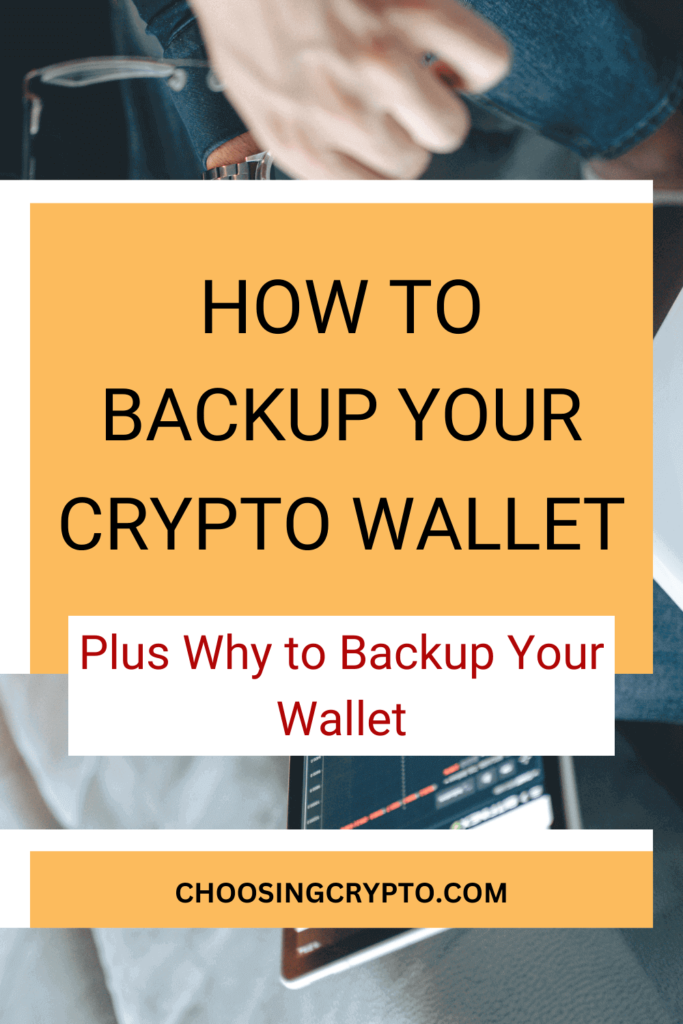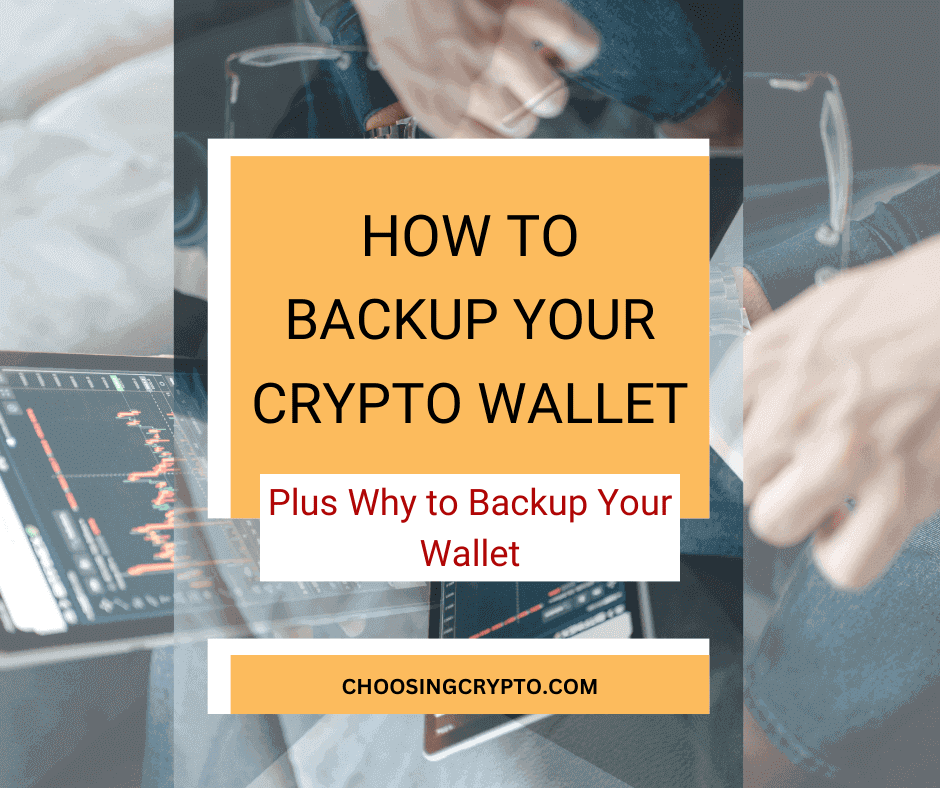Ever wondered how to backup your crypto wallet? Or why it’s such a big deal?
Imagine this: You’ve worked hard to stack up those digital coins, and then, out of the blue, your computer goes bonkers, or your phone decides to take a swim.
Without a backup, it’s like watching your money vanish into thin air – not a fun sight!
But fret not! I’ve got your back with a super-easy guide on how to backup your crypto wallet. Seriously, even your grandma could follow this.
Ready to take control of your crypto fate?
Come with me to understand why crypto wallet backups matter and how to make sure your cryptocurrencies stay safe and sound, no matter what the digital world throws at you.
Why Backup Your Crypto Wallet?
In the fast-changing world of cryptocurrency, where people can make or lose money online in a snap, it’s super important to keep your crypto wallet safe.
Let’s find out why it’s so vital to backup your crypto wallet.
- Human Error:
- We all make mistakes sometimes. You might accidentally delete an app, forget a password, or misplace your device, and that could mean saying goodbye to your crypto assets. But don’t worry! Think of a backup like a safety net that helps when we slip up. It’s there to lessen the impact when we make those everyday mistakes. So, keep a backup to keep your crypto safe and sound!
- Hardware and Software Risks:
- Your crypto wallet, whether it’s on your computer, smartphone, or a hardware device, can run into problems like hardware hiccups or software glitches. Imagine this: if something goes wrong and you haven’t backed up your wallet, it’s like waving bye-bye to your cryptocurrencies.
- Irreversibility of Transactions:
- Unlike regular banks, when you use cryptocurrency, once a transaction is confirmed, there’s no turning back. It’s like a one-way street – once you go, you can’t go back. Think about it: if something goes wrong and you can’t get to your money, having a backup is like your financial safety cushion. It’s there to catch you if something unexpected happens.
- Peace of Mind:
- Imagine a backup as your financial safety net. It’s like having insurance for your digital assets. When you know that your crypto is securely saved and can be retrieved in case of unexpected events, it brings a sense of calm. This assurance lets you move around the crypto world with confidence, knowing that your stuff is protected.
How to Backup Your Crypto Wallet
Now that we understand why it’s crucial to keep our crypto wallets safe, let’s get down to business and learn how to backup your crypto wallet.
I’ll walk you through the steps, making sure your cryptocurrency stays safe, whether you’re using a hot wallet or a cold one.
Hot Wallets (e.g., online wallets, mobile wallets)
1. Access Your Wallet:
- Open up your chosen crypto wallet on your device. Make sure you’re on a safe and private connection, especially if you’re handling a decent amount of money.
2. Locate the Backup or Recovery Option:
- Look around in your wallet’s settings or security area to find something like “Backup,” “Recovery Phrase,” or “Seed Phrase.”
3. Create a Strong Password:
- If it asks, set a strong and unique password for your wallet. This gives an extra layer of protection to your backup.
4. Generate the Recovery Seed (Mnemonic Phrase):
- Your wallet will generate a bunch of words, usually between 12 and 24. This is your recovery seed or mnemonic phrase. This phrase lets you recover your wallet if you lose your device.
5. Write Down the Seed on Physical Paper:
- Use a pen and paper to write down your recovery seed exactly as the wallet shows. Don’t take screenshots or save them on your device, as that could expose them to online threats.
6. Store the Backup in a Secure Location:
- Put your backup in a secure place. Think of options like a fireproof safe, a safety deposit box, or somewhere only you can get to.
7. Never Share Your Seed Phrase:
- It’s super important to keep your recovery seed secret. Don’t share it with anyone, and don’t store it digitally or in easy-to-reach places.
Note: You’ll also spot your recovery seed phrase when you’re setting up your wallet in the first place.
Cold Wallets (e.g., hardware wallets, paper wallets)
- Backing Up Hardware Wallets:
- Connectivity: While setting up your hardware wallet, follow the backup prompts provided by the device.
- Offline Storage: Ensure any backup files are stored securely offline, away from potential digital threats.
- Securing Paper Wallets:
- Printing Your Wallet: If using a paper wallet, print it out, making sure the printout is clear and legible.
- Physical Safekeeping: Store the paper wallet in a waterproof and fireproof container in a secure physical location.
Important Reminders:
- Test Your Backup: Your backup is only as good as its ability to restore your wallet. Once you’ve made a backup, try recovering it just to make sure you can get to your money when you need to.
- Periodic Checks: Regularly revisit and update your backup. As your crypto collection grows and changes, make sure your safety setup keeps up with the times.
When you follow these easy steps, you’re not just backing up your crypto wallet—you’re fortifying the walls of your digital fortress.
Common Crypto Backup Mistakes to Avoid
Now that we’ve covered the important steps for backing up your crypto wallet, it’s really important to know about some common mistakes that can put the security of your cryptocurrency at risk.
Let’s check out these potential hiccups and make sure your adventure into the crypto world stays trouble-free.
- Neglecting Regular Backups:
- Mistake: Assuming that one backup is sufficient for a lifetime.
- Solution: Periodically update your backups, especially after significant changes in your crypto holdings.
- Exposing Recovery Seed Phrases Digitally:
- Mistake: Taking screenshots or storing your recovery seed phrase on digital devices.
- Solution: Write it down on paper and keep it offline to reduce the risk of online exposure.
- Unsecured Storage of Physical Backups:
- Mistake: Storing wallet backups in easily accessible or unsafe locations.
- Solution: Choose a secure, waterproof, and fireproof physical storage solution.
- Ignoring Test Recoveries:
- Mistake: Creating backups but never testing their effectiveness.
- Solution: From time to time, give your funds a test run to make sure you can get to them when you want. It’s like checking that your keys work in the door – a quick and easy way to make sure everything’s ready for you when you need it!
- Overlooking Updates and Upgrades:
- Mistake: Ignoring wallet software updates or hardware firmware upgrades.
- Solution: Keep in the loop about updates and put them into action straight away to enjoy better security features.
- Relying Solely on Cloud Storage:
- Mistake: Using cloud services for backup without encrypting your wallet files adequately.
- Solution: If using cloud storage, encrypt your backup files and use secure, private cloud services.
- Sharing Backup Details Unwisely:
- Mistake: Sharing details of your backup strategy with others without considering the security implications.
- Solution: Keep your backups to yourself, and only share them with trustworthy folks when really needed.
Additional Security Measures
Well done on getting to this part of our guide!
As you dive deeper into the fascinating realm of cryptocurrencies, let’s check out some additional security measures that can make your online security even stronger.
These layers of protection go beyond simple backups and really beef up your digital defenses against possible issues.
- Use Strong, Unique Passwords:
- Why It Matters: Having a strong, one-of-a-kind password is like having a tough guard at the entrance, keeping unwanted visitors out.
- How to Do It: Create tricky passwords. Don’t use things that are easy to guess, like birthdays or common words.
- Secure Your Physical Backups:
- Why It Matters: Backups need protection from physical threats.
- How to Do It: Keep your physical backups safe by stashing them in a secure, fireproof, and waterproof box. You might even think about using a safe deposit box or another place away from your location for an extra layer of protection.
- Diversify Backup Locations:
- Why It Matters: Having backups in multiple locations reduces the risk of losing access due to a localized incident.
- How to Do It: Make sure you have copies of your backups in different places. You could keep them in a safe drawer at home, in a bank safety deposit box, or with a reliable family member.
- Educate Trusted Contacts:
- Why It Matters: In case of an emergency, it helps to have trusted contacts who are aware of your crypto holdings and backup methods.
- How to Do It: Let a close friend or family member know about your backup and how to recover your crypto wallet. Just make sure they get why it’s important.
By putting these extra security steps in place, you’re creating a strong defense to protect your crypto assets from possible problems.
Conclusion
Congratulations! You’ve just made a big move towards financial confidence by figuring out how to back up your crypto wallet.
In the big and always-changing world of cryptocurrency, a little bit of prep work can take you a long way.
So, give yourself a pat on the back for spending the time to protect your crypto stash.
Now that you know the ropes and have a safely backed-up wallet, you’re not just a beginner in the crypto game—you’re a smart investor all set for success.
Just keep in mind, that this is just the start of your crypto adventure, and there are heaps of exciting possibilities ahead.
Additional Resources
Excited to learn more about Bitcoin and cryptocurrencies? We’ve got some awesome resources below to help you out.
And guess what? We’re also on Instagram and Twitter(X). Join us there for even more fun and useful content!
Additional Resources:
- 5 Best Crypto Mobile Wallets to Use
- Cryptocurrency Hot Wallet vs Cold Wallet
- How to Start Trading Crypto Successfully as a Beginner
- Best Crypto Hardware Wallets for Storing Crypto Offline
- 7 Best Ways to Secure Your Cryptocurrencies
- Best Crypto Exchanges to Use
- Why You Keep Losing Money in Crypto

IMPORTANT; Don’t ever send money to someone online who says they’ll help you invest in cryptocurrency. They’re probably up to no good – you know, scammers and all.
DISCLAIMER:
The information provided here is intended for informational purposes only and should not be solely relied upon for making investment decisions. It does not constitute financial, tax, legal, or accounting advice. Additionally, I strongly recommend that you only invest in cryptocurrency an amount you are comfortable with potentially losing temporarily.
Read Also: Understanding Crypto Wallets: The Best And Safest Wallets to Use
